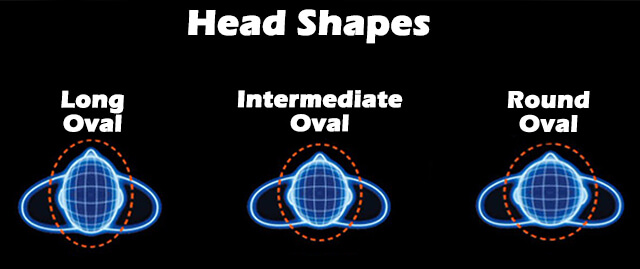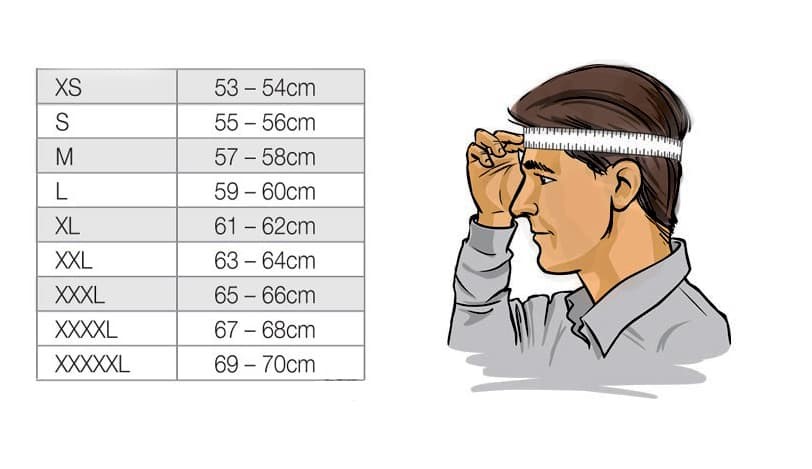There is no way a motorcyclist can do without equipment, the main element of which is a motorcycle helmet. What should you pay attention to when buying a helmet? Style, design, color – all these things matter, but only if you choose the right type and size of helmet.
Most likely, the question of measuring the size of a helmet is of interest to a beginner who buys a helmet for the first time or perhaps you just have not bought a new helmet for a long time. In any case, it will be useful for you to familiarize yourself with the material below.

With today’s variety of motorcycle helmets, it would seem that it is not difficult to stop at a particular model. But practice shows that the novice bike owners pay attention to the wrong things. The first thing to look not at the design but the shape and type of motorcycle helmet.
That is why it is important to find the right size and choose a model suitable for the shape of your head, and then you should listen to your feelings. To make your choice of helmet easier we have prepared some useful tips for you.
The shape of your head
In addition to head and helmet size, you also need to take into account the individual shape of your head to get the perfect fit for your motorcycle helmet. There are several human head shapes:
- Long oval heads in most people (long shape from forehead to crown and tapered sides at temples).
- Round oval (more rounded head with widened sides at the temples)
- Intermediate oval (the head is longer than wide, but not very narrowed on the temple side).

Deciding on the type of motorcycle helmet
-

Full face. A helmet with good noise insulation and better protection. Designed for sportbikes and high-speed riding, as evidenced by its high aerodynamic properties. Can be either touring or racing – depends on the location of the visor, which in the second case is placed a little higher than in the first, to keep a view of the landing.
-

Modular. The model is designed for motorcyclists who have to be on wheels for a long time. The peculiarity of the modular is a lifting visor so that the motorcyclist had the opportunity to have a snack, smoke, and talk, without removing the helmet. But the loose fit on the head creates inconvenience when riding at high speed: blows the wind.
-

Open face or 3-4 motorcycle helmet. The model protects the head, but the neck remains open and unprotected. Such a helmet can be recommended for those who never rush behind the wheel, and ride calmly.
-

Half helmet. This is more of a decorative element of motorcycle equipment, providing protection only for the upper head, and then at the lowest level.
-

Motocross. Owners of enduro and similar motorcycles, who like to compete on rough terrain with logs and other obstacles need enhanced head protection. This helmet has excellent ventilation, low weight, and a special visor.
How to size and buy a motorcycle helmet
-
Step 1. First, you should measure the circumference of the head with a sewing measuring tape or steel soft measuring tape.
This is done very simply: over the ears, we measure the circumference of the head at its widest part (if there is no measuring ruler, use a string or a rope around the head, and then measure the resulting length with a ruler or yardstick). As a rule, you need to measure the head circumference at a distance of 0.6-1 inch above the eyebrows, slightly above the ears and at the point on the back of the head that gives you the longest circumference. Measure your head several times to avoid mistakes and find the maximum circumference.

-
Step 2. Now compare your result with the helmet sizes shown in the summary tables below.
Each helmet size corresponds to a certain head circumference in centimeters or inches. Since different manufacturers produce hard shells of completely different shapes and sizes, they can classify the sizes of their helmets in different ways. Below are tables of the sizes of helmets and the length of the head circumference, depending on the brand of helmet and manufacturer. If you are firmly convinced that you want to buy a helmet of a particular brand, for example, Arai or Shoei, see the corresponding table (or read the recommendations on the manufacturer’s website).
Arai Helmet SizingSIZE HEAD (CM) HEAD (INCH) 2XS 51-52 20 -20 1/2 XS 53-54 20 7/8 - 21 1/4 SM 55-56 21 5/8 - 22 MD 57-58 22 1/2 - 22 7/8 LG 59-60 23 1/4 - 23 5/8 XL 61-62 24 - 24 3/8 2XL 63-64 24 3/4 - 25 1/8 3XL 65-66 25 5/8 - 26 Vega Helmet SizingSIZE HEAD (CM) HEAD (INCH) S 55-57 21 5/8 - 22 1/2 M 57-59 22 1/2 - 23 1/4 L 59-61 23 1/4 - 24 Shoei Helmet SizingSIZE HAT SIZE HEAD (CM) HEAD (INCHES) XS 6 5/8 - 6 3/4 53-54 20 7/8 - 21 1/4 SM 6 7/8 - 7 55-56 21 5/8 - 22 MD 7 1/8 - 7 1/4 57-58 22 1/2 - 22 7/8 LG 7 3/8 - 7 1/2 59-60 23 1/4 - 23 5/8 XL 7 5/8 - 7 3/4 61-62 24 - 24 3/8 2XL 7 7/8 - 8 63-64 24 3/4 - 25 1/8 3XL 8 1/8 - 8 1/4 65-66 25 5/8 - 26 Icon Helmet SizingSIZE HAT SIZE HEAD (CM) HEAD (INCHES) 2XS 6 3/8 - 6 1/2 51-52 20 1/8 - 20 1/2 XS 6 5/8 - 6 3/4 53-54 20 7/8 - 21 1/4 SM 6 7/8 - 7 55-56 21 5/8 - 22 MD 7 1/8 - 7 1/4 57-58 22 1/2 - 22 7/8 LG 7 3/8 - 7 1/2 59-60 23 1/4 - 23 5/8 XL 7 5/8 - 7 3/4 61-62 24 - 24 3/8 2XL 7 7/8 - 8 63-64 24 3/4 - 25 1/8 3XL 8 1/8 - 8 1/4 65-66 25 5/8 - 26 -
Step 3. If you see that two sizes of helmets may suit you, it is preferable to focus on a smaller size. Moreover, some of the inner linings of helmets tend to wear out a little over time.
-
Step 4.When placing an order, ask the consultant how closely the size chart matches the actual characteristics of the product.
Often, consultants have information on the features of a particular model or brand of helmet. Also, read reviews about the store and the specific products in this store. Ask about the possibility of a return or exchange.
When you order a helmet online and measure its size in this way, take into account the risks – the helmet may turn out to be too big or small and simply will not work for you.
Reasons why the helmet may not match the circle in size:
- the manufacturer does not adhere to its size grid (rarely, but this happens even inexpensive price segments);
- the shape of the head does not always coincide with the shape of the helmet (heads with the same circumference may have different shapes, for example, the helmet may not fit in height).
So what is the best way to try on a helmet in a store?
- When you put on a helmet and fasten it, try shaking your head with short sharp movements in different directions. If the helmet easily moves around, then you chose the wrong size. It is unsafe and uncomfortable due to wind blowing, whistling and noise.
- Try to get a finger between the head and the helmet in the temple or frontal area. If you can do it, you should most likely choose a smaller size.
- Take a closed and fastened helmet with one hand on the back of the head and try to shake it up and down or pull it off your head through the front. If a helmet easily moves back and forth, then this is not your size.
- If you feel strong pressure in the forehead and discomfort, you need to try on a larger size.
- After putting on a helmet, walk in it for at least ten minutes to assess the level of comfort and to understand if it puts a lot of pressure on your head.
Conclusion
Depending on our head shapes and helmet types, we may feel differently about helmets from different manufacturers. We may be more comfortable in one helmet than in another depending on the comfort fit of the helmet, the thickness, and material of the lining, the padding from different densities of the inner liner, and the padded cheek function.
And before you finish, remember that in terms of safety, a motorcycle helmet is the most important piece of protection for a motorcyclist. Its selection should be taken very seriously because safety, comfort, and convenience when riding a motorcycle will depend on it.
Adjust your helmet’s chin strap tightly and be sure to fasten it before each ride!

